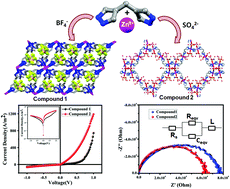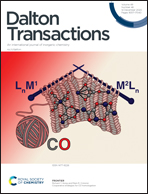Utilization of counter anions for charge transportation in the electrical device fabrication of Zn(ii) metal–organic frameworks†
Abstract
The present work reports the fabrication of anion-induced electrical devices with Zn(II) metal–organic frameworks. The essence of our electronic device fabrication is to utilize the anionic species entrapped inside of the three-dimensional network of the MOFs for charge transportation. The idea is to generate MOFs as a host–guest system with encapsulated anions or anion–solvent clusters as guests and a cationic yet insulating three-dimensional framework as the host. Accordingly, we have synthesized two Zn(II) MOFs using a neutral bispyrazole-based ligand, which results in a cationic chassis with substantial void space and porous channels inside the network. For both MOFs, the porous channels are occupied by infinitely hydrogen bonded networks of anions and anion–solvent clusters. This provides an excellent platform for anionic species-induced charge transportation and improved electrical conductivity. Indeed, the impedance spectroscopy data and current density–voltage (J–V) characteristics of the fabricated electrical devices further vindicate our idea. The current–voltage measurements clearly indicate the usefulness of modified host–guest-type MOFs for electronic device fabrication with corroborating conductivity values of 8.71 × 10−5 S m−1 and 5.79 × 10−4 S m−1 for compound 1 and compound 2, respectively.



 Please wait while we load your content...
Please wait while we load your content...